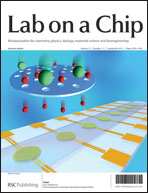Nanoporous micro-element arrays for particle interception in microfluidic cell separation
Abstract
The ability to control cell-surface interactions in order to achieve binding of specific cell types is a major challenge for microfluidic immunoaffinity cell capture systems. In the majority of existing systems, the functionalized capture surface is constructed of solid materials, where flow stagnation at the solid-liquid interface is detrimental to the convection of cells to the surface. We study the use of ultra-high porosity (99%) nanoporous micro-posts in microfluidic channels for enhancing interception efficiency of particles in flow. We show using both modelling and experiment that nanoporous posts improve particle interception compared to solid posts through two distinct mechanisms: the increase of direct interception, and the reduction of near-surface hydrodynamic resistance. We provide initial validation that the improvement of interception efficiency also results in an increase in capture efficiency when comparing nanoporous vertically aligned


 Please wait while we load your content...
Please wait while we load your content...